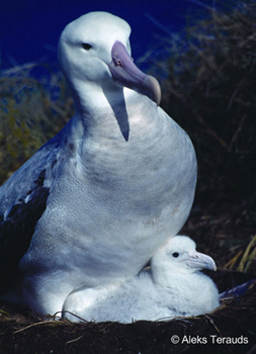Being a graveyard ornithologist is to leave valuable data in notebooks unanalysed and unpublished. In a paper recently published in the open-access journal Marine Ornithology John Van Den Hoff & Steven Candy (Australian Antarctic Division) have taken growth-rate data collected on Wandering Albatrosses Diomedea exulans at Macquarie Island fully half a century ago and compared it with similar temporal data from Bird Island in the South Atlantic.
The paper's abstract follows:
"Offspring growth measurements provide an integrated measure of parental investment (foraging effort and success) and an indicator of offspring future survivorship. We present an average growth (mass) trajectory for Wandering Albatross Diomedea exulans chicks (n = 26) weighed at sub-Antarctic Macquarie Island during four breeding seasons between 1956 and 1962. Specified growth parameters were estimated using a nonlinear mixed model for an extension of the Gompertz model and, as an alternative, cubic smoothing splines within a linear mixed model. Both modelling approaches revealed that the chicks from Macquarie Island gained mass more slowly and reached a lower maximum mass than chicks weighed at Bird Island, the only other temporally aligned study for this species. After reaching maximum mass, chicks from Bird Island lost mass faster than Macquarie Island chicks, resulting in very similar fledging masses for chicks at both islands. One explanation for the different growth parameter estimates observed between the two islands is historical differences in productivity of foraging areas. The data presented here for Macquarie Island provide a baseline against which future studies could compare the effects of climate change and commercial fisheries on this long-lived and charismatic seabird species."

Reference:
VAN DEN HOFF, J. & CANDY, S.G. 2010. Historical geographic differences in growth parameters of Wandering Albatross Diomedea exulans chicks. Marine Ornithology 38: 97-103.
John Cooper, ACAP Information Officer, 12 March 2011

 English
English  Français
Français  Español
Español